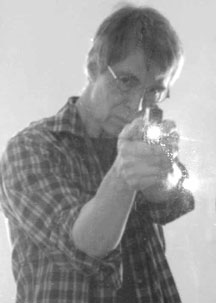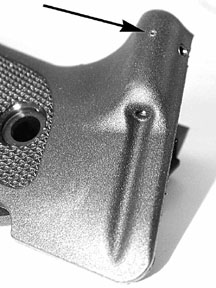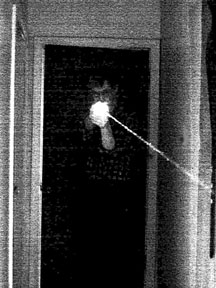
An attempt to evaluate laser sights on handguns is not easy. One of the main principles of handgun shooting, as taught by the finest instructors worldwide, must be violated if a laser sight is utilized. With iron sights, one must keep ones focus on the front sight to hit the target. No point shooting is ever utilized, except by the most advanced pistoleros and then under very specific conditions that are generally restricted to arms-length ranges.
The use of any laser sight requires the shooter to focus on his target, not the front sight. Therefore, you have to decide which of two disciplines to use in each given scenario. If you choose to install a laser sight and forego the front sight focus, it may very well suffice for most self-defense situations. But how about outdoors in bright light, when the target is not very close? How much time do you spend looking for a red dot that may not be visible under those conditions, before you switch your focus back to the front sight? Well touch on this point again.
SWAT or other team use of laser-equipped pistols – or rifles, for that matter – can be fraught with grave danger, or at least massive and time-delaying uncertainty: You and your partner charge into a hostage situation, both of you using laser-sighted weapons. You see a felon holding a pistol to a hostages head. You see two red dots, one on the felon and one on the hostage. Do you take the shot? Which dot is yours?
The first impression a trained non-laser shooter gets when first trying one of these devices is that the master eye sees way too much information. We found it took a great effort to raise the head off the front sight to look for the red dot. It was completely unnatural, yet such a move is necessary if you use a laser sight. Most of our shooters got the impression there was too much information being presented, at least in normal-light situations, for those untrained with lasers. Most experienced shooters in our group did not like the laser sights. As we gained experience with them, that opinion remained.
However, with our increased exposure to laser technology, some of us could see potential slight advantages in dim light conditions, such as in the home at night. Of course tritium-type night sights are a viable option in dim light, and because most shootings take place in dim light, we feel all self-defense handguns need night sights. We realized laser sights may have advantages for some shooters under some situations, particularly those with not a lot of combat-type shooting experience, which probably covers most handgun owners, come to think of it. There may be an intimidation factor. The bad guy sees that red dot playing all over him, and suddenly remembers all the TV shows and movies hes seen that used laser dots as visual threats (so the audience realizes theres about to be a shooting). The bad guy will then immediately give up, or run away. Or so it is claimed, by those who sell lasers. Despite those claims, we suspect there could be any number of responses, not all of them the intended ones. The red dot could conceivably cause the offender to initiate deadly action.
The Laser Contradiction
Here are some aspects of laser sights you wont read in their ads. The laser gives the position of the shooter away. Its very possible that you will not immediately see your target, particularly in dim light. As you swing your laser around looking for the target, anyone remotely in front of your gun will be able to see its bright red dot on the front of your weapon. Crooks are generally not alone, so even if youve got one in your sights, youre a sitting duck for the others. Also, for a real treat, point the laser into a mirror or reflective surface at night. Youll see a lot more than one red dot. Put two, three, or more laser-sighted guns in a darkened room with mirrors or glass at night, and then try to sort things out. And do it before you get shot.
The Units
There are two generally available laser systems, one by Crimson Trace and one by LaserMax. The Crimson Trace folks make Lasergrips, $389 MSRP, which are produced for a great variety of revolvers and auto pistols. You replace whatever grips you have on your gun with the Lasergrips, adjust the laser, and youre all set. Although the grips are generally soft rubber, several designs are available for the more common handguns, so you can choose grips to suit your hand. Lasergrips can be fitted to a wide variety of handguns. Crimson Traces Lasergrips mount the laser on the right grip. Thus the line of the lasers light is somewhat to the side of the bore. You can adjust the light so bullets strike where the laser looks at a specific distance, or so that bullets fly parallel to the light and always strike to the left of the dot.
The $329 MSRP LaserMax, on the other hand, is designed to replace the guide rod on certain semiauto pistols, and is thus not an option for revolvers. One advantage of the LaserMax is that the laser is directly beneath the bore. Bullets fly just above the path of the laser, which is not adjustable for impact. For a given pistol the two systems are similar in cost, generally just over $300 street price.
We had the loan of a SIG P229 and a Glock 22 and tried both guns with both types of lasers. The Glock 22 arrived with a special Crimson Trace Lasergrip system installed that proved the exception to the above rule. Its laser was directly beneath the bore. Underneath the trigger guard was a tiny microswitch, fully shielded from dust and moisture by a thin rubber cover. In normal grasping of the gun with either hand, the middle finger clamps upward on that microswitch, igniting the laser. There was also a master switch at the bottom of the butt behind the magazine. It had to be pressed inward firmly before it could be moved, so it stayed where you put it. The laser itself was mounted in an aluminum housing that attached to the trigger guard with two cross pins. The laser was adjustable for windage and elevation by Allen screws. We liked this setup quite a lot. It gave us the laser effortlessly whenever we grasped the Glock, as long as the master switch was on. The CT laser was extremely bright and commanded our attention whenever we pointed it at anything.

Installing the LaserMax into the SIG was a breeze. It required only stripping the gun and pulling out the takedown lever, and replacing that with a similar part that held the switch. Then the laser/battery package was inserted in place of the slide-spring guide rod. It went in easily and worked right from the start. The LaserMax system had only one switch. It protruded from both sides of the frame, just in front of the trigger guard. Whenever you wanted the laser, you had to press on either end of that switch. A firm push with the trigger finger, or weak-hand thumb, turned on the light. The laser would stay on until you turned it off, even if you set the gun down. Centering the switch turned the light off. The bad news is that it was hard to push the button far enough to keep the light lit, and it got worse the more we tried to speed things up. Wed get a brief red dot, and then the light went off again when we needed it. The switch required a strong press with the trigger finger, and it wasnt natural. Pressing with the weak-hand thumb worked, but that meant the full shooting grip wasnt available until you replaced your weak hand in the proper position. The good news is that with the LaserMax, the shooter could decide if he wanted the laser on, a brief burst of red, or no light at all.
The CT and LaserMax lasers were about equally bright in a dim room. The biggest difference was that the LaserMax units pulsed, which we found annoying, while the Crimson Trace was steady. Outdoors in bright light, it was clear that the Crimson Trace Lasergrip was much the brighter system. We could see its dot more easily and much faster at a distance. In bright light both systems gave acceptable bright dots on close targets. However, on targets a bit more distant, the Crimson Trace was much easier to see. We pointed them both at a large gray rock at 25 feet distance, and it seemed to us that either system would work fine for defining the point of impact. Then we pointed them both at a reddish telephone pole 35 feet away, and had trouble seeing the dot from the LaserMax system. Then we pointed them both at a gray tree about 40 feet away, and could see both dots equally. So we had discovered the dots visibility on mid-range targets in bright light depended to a large extent on the color of the target.
We aimed both lasers at a small gray rock at about 25 yards distance, and could just barely see the LaserMax light. The Crimson Trace was more readily visible, but quite dim at that range. Most important, we found that we had to use the iron sights to find the dim laser on distant targets. We noted it was much faster for trained shooters to make hits with iron sights than with lasers at medium range. Up close it made little difference. We always used two hands and brought the gun to eye level. If the target were close enough to justify point shooting, it made no difference to have laser sights or not.
We found it was impossible to turn on the LaserMax sight as the gun was presented, while shooting fast. We left it on for our evaluations. Also, we could not always guarantee that our speedily acquired grip on the Glock would turn on its light. As a result, we often found ourselves looking for a laser that wasnt lit, not the sort of thing youd want in a gunfight. We switched systems, trying the Crimson Trace grips on the SIG and the LaserMax in the Glock, but our conclusions remained about the same, with the happy exception that the Lasergrip on the SIG was very reliable. It came on every time we grabbed the gun, unlike what we found with the Glock.
We thought the Crimson Trace was the slightly more useful product of the two systems tested. It gave a brighter light that was easily lit whenever the gun was presented, and was thus far faster to put into action when it was wanted. It could be overridden by the master switch, and thus gave added convenience, plus avoidance of accidental battery rundown.
The LaserMax hid well within the gun, and required almost no external changes. That let the shooter use whatever grips he wanted. The LaserMax required no focusing once it was installed, and we found them to point close enough to the iron sights in our two installations that we would be confident of bullet placement at normal combat ranges with this system.
Neither sight, we felt, would be ideal for the most demanding target shooting, but either would work well for plinking. For those with certain vision problems, laser sights may be a good way to keep on shooting. There is, after all, no reason laser sights have to be restricted to self-defense uses.
In summary, we found that laser sights may have some uses, and both of these systems got a BUY IT rating, but thoroughly experienced shooters will probably not want them. For bright light situations, our shooters didnt much like the lasers, preferring to trust years of experience in training the eye to look for, and focus on the front sight once the decision to shoot has been made.
The laser does give off some visible light that may or may not help in low-light situations. But in dim light, we would prefer a bright white push-button light, controlled by the weak hand. Such a light would be used by pulsing it for a quick look, turning it off and then moving as quickly as possible. When shined brilliantly into the face of an intruder, we felt it would have a far greater intimidation factor than any laser dot.

Users Experiences
We talked about laser-sighted pistols with a shooter who has had Crimson Traces Lasergrips on his Kimber .45 for some time. He claimed he could start putting bullets on target as soon as the pistol was out of his holster (point shooting), and thus lost no time bringing the pistol to eye level. He added that this advantage was more noticeable in low-light conditions. But in our collective IPSC and other competition experience, there is not much time lost bringing the pistol to eye level during a proper presentation, and much to be gained. The two-handed grip is secured an instant after the gun leaves the holster, and both hands then shove the pistol toward the target and lock onto it in a flash. There is thus no doubt about when to point shoot and when to aim, because all shots are aimed, always. Having said that, we know of one extremely advanced shooter who grudgingly advocates what he calls the speed rock for fastest point shooting at arms-length range, but we know of no living instructor who recommends point shooting for any purpose; not since Rex Applegate died. The reasons are based on legal matters, on accuracy, weapon retention, recoil control, and a host of other factors. When you have to hit the target, use your sights.
Gun Tests Recommends
Our contact who said he could save time with laser sights (and we dont doubt him) also stated that he felt so confident in them that hed trust the red dot over the guns iron sights in a tight spot. We thought it says a lot for lasers that they permitted that experienced shooter to make such a claim. Yet this same fellow practices with both iron sights and the laser, to keep his hand in if the laser or its battery suddenly quit. He said, …in a tense situation I would prefer to see the red dot before I pull the trigger. But what if he doesnt see the dot? How much time will he lose looking for that red dot before he pulls his focus back to the front sight to make the shot? Think well on that. But if you decide to buy a laser, heres what we would choose:
Crimson Trace Lasergrips, $389. Our Pick. The Crimson Trace units seemed brighter overall than the LaserMaxes. We could generally see the CT dot better, which is the deciding factor. Also, Lasergrips can be fitted to a variety of handguns.
LaserMax Guide Rods, $329. Buy It. The LaserMax units pulsed, which annoyed us. Theyre also limited to pistols. Nonetheless, we see some situations in which we would prefer these units over having to change the grips, as required by the LaserGrips. Both systems will do the job as promised, but we would prefer nights sights instead.
-Ray Ordorica
———-
Trigger Video Review
The home gunsmith who wants to learn how to smooth trigger function should take a look at the instructional video Trigger Job from GunVideo, featuring Jerry Miculek. Ten minutes into the video youll want to run out buy a new Smith & Wesson and sit down in front of the VCR and polish along with Mitch.
The video begins with the obligatory trailer of Miculek shooting fast and reloading quickly. But its Miculeks self-assured disassembly and explanation of the revolver mechanism and its refinement that will draw in the viewer.
The video is two hours in length. but plays much faster. While pertinent to any model S&W, the concepts and techniques may be applied to any revolver and only a handful of tools are needed to complete the job. By the time Jerry reassembles the model 10 in hand, you should be ready to work along side this video at your workbench with little fear. For more information on the $29.95 video, contact GunVideo, 4585 Murphy Canyon Rd., San Diego, CA 92123, (800) 942-8273, www.gunvideo.com.
-Roger Eckstine


























